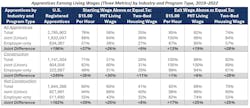Latest from Around the Web
Sponsored
DOL Study: Registered Apprenticeships Expand Access to Living Wages for Millions of Workers
CHICAGO, IL — A new study commissioned by the United States Department of Labor has revealed that registered apprenticeship programs—career training alternatives to college in which enrollment has doubled over the past decade—dramatically increase the ability of participants to afford basic needs in their communities, with union-affiliated programs delivering the biggest gains across all occupational sectors. The research was performed by Economist Frank Manzo IV of the Illinois Economic Policy Institute (ILEPI) and Professor Robert Bruno of the Project for Middle Class Renewal (PMCR) at the University of Illinois at Urbana-Champaign.
Read the Report, Living Wages in Registered Apprenticeship Programs: An Assessment by Industry, Demographics, State, and Labor Policy.
Registered apprenticeships are training programs in which participants “earn while they learn” and obtain portable, nationally recognized occupational credentials, with tuition costs covered either by employers alone or through joint labor-management organizations negotiated through the collective bargaining process.
The vast majority of registered apprenticeship investment in the United States occurs through the joint (union-affiliated) apprenticeship model, which also delivers better wages, completion rates, and workforce diversity metrics. Lasting between one and six years, apprenticeship programs are structured such that participants earn lower wages as they begin their class-based instruction and on-the-job training, with higher hourly incomes as they progress. These graduated wage scales are typically tied to a percentage of the exit wage (or journeyworker rate), which incentivizes employers to hire apprentices who are more affordable on a per-hour basis than fully trained journeyworkers while building long-term careers for workers in industries with high demand.
Methodology
For their report, Manzo and Bruno analyzed data on nearly 2.8 million registered apprentices from the US Department of Labor’s Registered Apprenticeship Partners Information Management Data System (RAPIDS) between 2019 and 2022. The data was then compared against three living wage metrics—a $15 per hour wage, an earnings level below which nearly one-third of working Americans fell during this period; the Massachusetts Institute of Technology’s (MIT) Living Wage Calculator, which estimates the employment income that full-time workers must earn per hour to cover costs for basic needs, such as food, childcare, health care, housing, and transportation; and the National Low Income Housing Coalition’s (NLIHC) published standard of the wage needed for workers to afford modest two-bedroom apartments in their communities.
“Overall, the data show that from the starting wage to the exit wage, registered apprenticeship programs deliver significant expansions in access to living wages for participants across the country,” Manzo said. “That said, the data also reveals that differences in program structure, industry, location, and labor policy can either mute or amplify the success of these proven workforce development institutions.”
Key Findings
Across all program types, regions, and occupations, the study showed that 76 percent of all apprentices earned starting wages of $15 per hour or more, 56 percent earned living wages based on the MIT Living Wage Calculator, and 35 percent earned starting wages that were enough to afford two-bedroom apartments at fair-market rent in their communities. For those who completed their programs, 95 percent earned wages at or above $15 per hour, 92 percent could cover basic expenses, and 74 percent could afford two-bedroom apartments. However, researchers found that once program type, location, and occupation were considered, important distinctions were revealed.
For example, apprentices in joint labor-management programs were significantly more likely to meet living wage thresholds, both from day one and after graduating. This was especially true in the construction sector, which currently accounts for the majority of registered apprenticeships in the United States and where nearly all completers from joint labor-management programs earned at least $15 per hour (100 percent) and living wages according to the MIT Calculator (98 percent).
“The data makes clear that apprenticeships are a viable pathway to living wage careers, and that partnerships between employers and trade unions are the most effective framework for delivering these outcomes at scale,” said Bruno. “The historic growth of these programs and demand for debt-free career development alternatives argues strongly for policies that can bolster the registered apprenticeship system across the United States.”
Joint Labor-Management Programs
While registered apprenticeships boost access to living wages across all industries, the authors noted that union affiliation and state-level labor policy interventions can also have significant effects. To analyze these distinctions, authors used advanced statistical analyses to parse out the impacts of participating in joint labor-management programs, the presence of prevailing wage laws that establish local-market minimum wages and training standards for construction workers on public works projects, and the impact of “right-to-work” laws that erode the resources that unions would otherwise have available—including to collectively bargain with employers over wages and training investments.
“Apprentices in joint labor-management programs and those in states with prevailing wage laws have higher completion rates, earn significantly higher starting and exit wages, are much more likely to earn living wages,” Manzo added. “On the other hand, so-called ‘right-to-work’ laws are correlated with worse completion rates, lower wages, and fewer apprentices earning $15 per hour or achieving other living wage thresholds.”
“Overall, the data suggests that policymakers could look to the example of joint labor-management programs in construction if they want to expand registered apprenticeships to other industries and ensure that they deliver living wages to their participants,” Dr. Bruno concluded. “It is equally clear that policies that strengthen collective bargaining rights and encourage greater levels of cooperation between employers and unions would decidedly bolster the US system of registered apprenticeships, improve completion rates, deliver upward economic mobility for more Americans pursuing careers that do not require college degrees.”




